PONTIAC VIBE 2004 Owners Manual
Manufacturer: PONTIAC, Model Year: 2004, Model line: VIBE, Model: PONTIAC VIBE 2004Pages: 370, PDF Size: 2.68 MB
Page 91 of 370
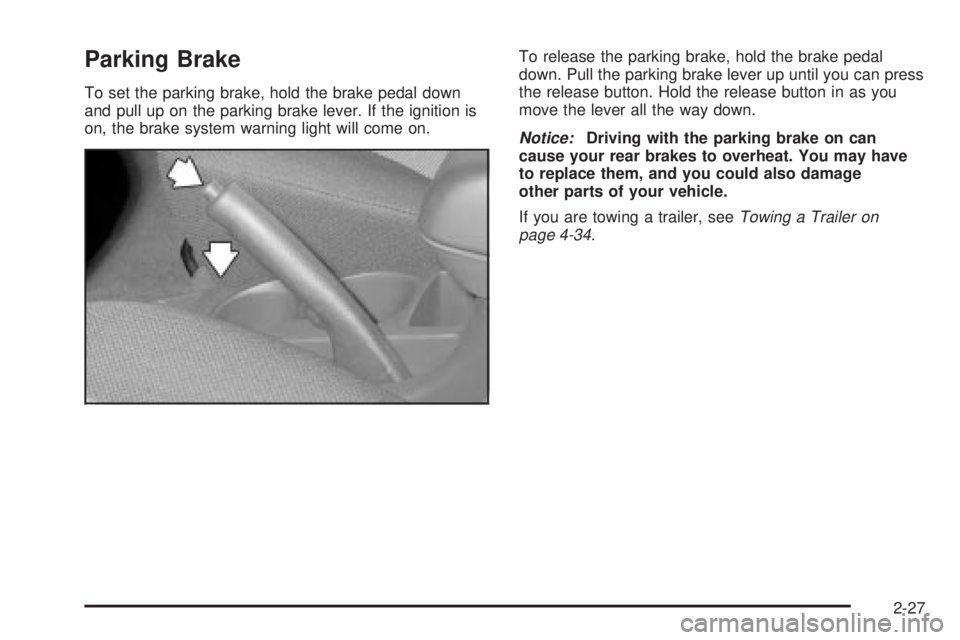
Parking Brake
To set the parking brake, hold the brake pedal down
and pull up on the parking brake lever. If the ignition is
on, the brake system warning light will come on.To release the parking brake, hold the brake pedal
down. Pull the parking brake lever up until you can press
the release button. Hold the release button in as you
move the lever all the way down.
Notice:Driving with the parking brake on can
cause your rear brakes to overheat. You may have
to replace them, and you could also damage
other parts of your vehicle.
If you are towing a trailer, see
Towing a Trailer on
page 4-34.
2-27
Page 92 of 370
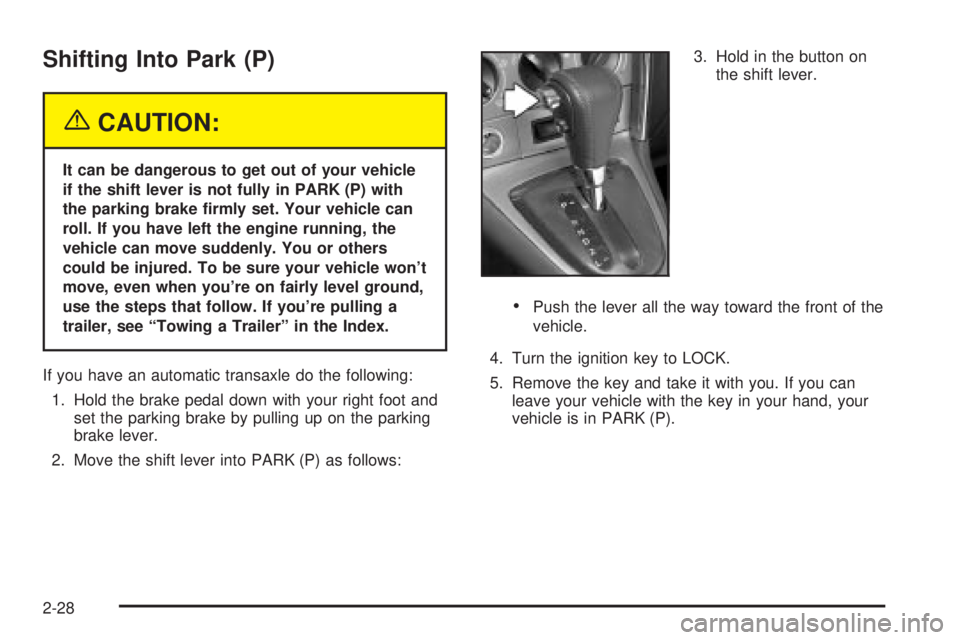
Shifting Into Park (P)
{CAUTION:
It can be dangerous to get out of your vehicle
if the shift lever is not fully in PARK (P) with
the parking brake ®rmly set. Your vehicle can
roll. If you have left the engine running, the
vehicle can move suddenly. You or others
could be injured. To be sure your vehicle won't
move, even when you're on fairly level ground,
use the steps that follow. If you're pulling a
trailer, see ªTowing a Trailerº in the Index.
If you have an automatic transaxle do the following:
1. Hold the brake pedal down with your right foot and
set the parking brake by pulling up on the parking
brake lever.
2. Move the shift lever into PARK (P) as follows:3. Hold in the button on
the shift lever.
·Push the lever all the way toward the front of the
vehicle.
4. Turn the ignition key to LOCK.
5. Remove the key and take it with you. If you can
leave your vehicle with the key in your hand, your
vehicle is in PARK (P).
2-28
Page 93 of 370

Leaving Your Vehicle With the Engine
Running
{CAUTION:
It can be dangerous to leave your vehicle with
the engine running. Your vehicle could move
suddenly if the shift lever is not fully in
PARK (P) with the parking brake ®rmly set.
And, if you leave the vehicle with the engine
running, it could overheat and even catch ®re.
You or others could be injured. Don't leave
your vehicle with the engine running.If you have to leave your automatic transaxle vehicle
with the engine running, be sure your vehicle is in
PARK (P) and your parking brake is ®rmly set before
you leave it. After you've moved the shift lever into
PARK (P), hold the regular brake pedal down. Then, see
if you can move the shift lever away from PARK (P)
without ®rst pulling it toward you. If you can, it means
that the shift lever wasn't fully locked into PARK (P).
2-29
Page 94 of 370
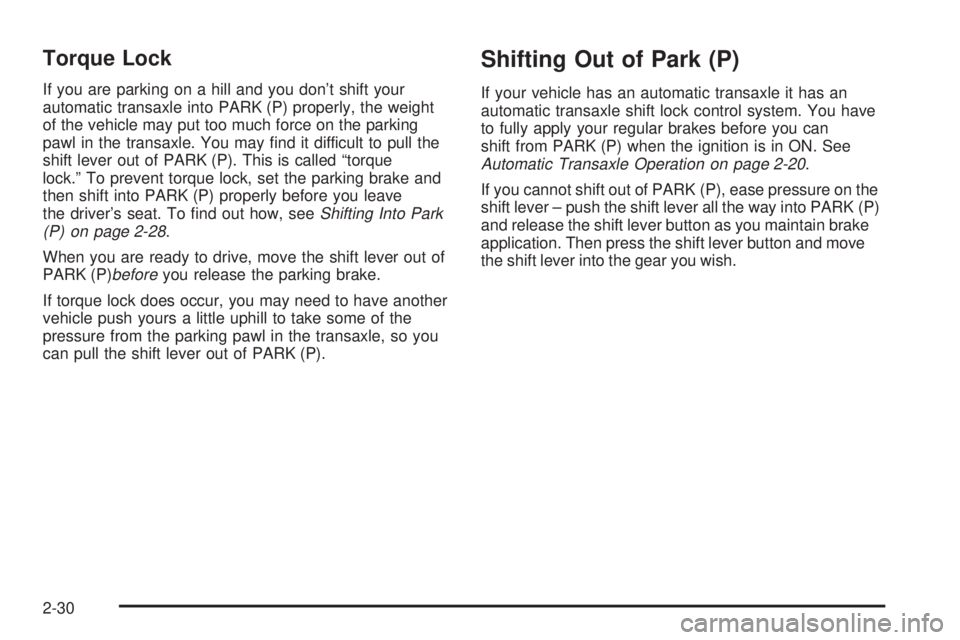
Torque Lock
If you are parking on a hill and you don't shift your
automatic transaxle into PARK (P) properly, the weight
of the vehicle may put too much force on the parking
pawl in the transaxle. You may ®nd it difficult to pull the
shift lever out of PARK (P). This is called ªtorque
lock.º To prevent torque lock, set the parking brake and
then shift into PARK (P) properly before you leave
the driver's seat. To ®nd out how, see
Shifting Into Park
(P) on page 2-28.
When you are ready to drive, move the shift lever out of
PARK (P)
beforeyou release the parking brake.
If torque lock does occur, you may need to have another
vehicle push yours a little uphill to take some of the
pressure from the parking pawl in the transaxle, so you
can pull the shift lever out of PARK (P).
Shifting Out of Park (P)
If your vehicle has an automatic transaxle it has an
automatic transaxle shift lock control system. You have
to fully apply your regular brakes before you can
shift from PARK (P) when the ignition is in ON. See
Automatic Transaxle Operation on page 2-20.
If you cannot shift out of PARK (P), ease pressure on the
shift lever ± push the shift lever all the way into PARK (P)
and release the shift lever button as you maintain brake
application. Then press the shift lever button and move
the shift lever into the gear you wish.
2-30
Page 95 of 370
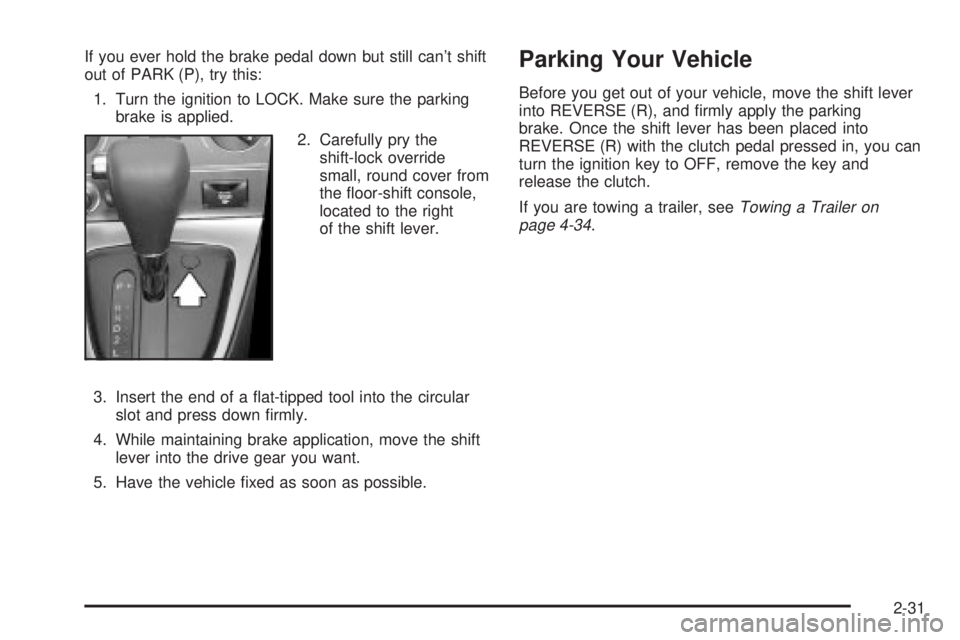
If you ever hold the brake pedal down but still can't shift
out of PARK (P), try this:
1. Turn the ignition to LOCK. Make sure the parking
brake is applied.
2. Carefully pry the
shift-lock override
small, round cover from
the ¯oor-shift console,
located to the right
of the shift lever.
3. Insert the end of a ¯at-tipped tool into the circular
slot and press down ®rmly.
4. While maintaining brake application, move the shift
lever into the drive gear you want.
5. Have the vehicle ®xed as soon as possible.Parking Your Vehicle
Before you get out of your vehicle, move the shift lever
into REVERSE (R), and ®rmly apply the parking
brake. Once the shift lever has been placed into
REVERSE (R) with the clutch pedal pressed in, you can
turn the ignition key to OFF, remove the key and
release the clutch.
If you are towing a trailer, see
Towing a Trailer on
page 4-34.
2-31
Page 96 of 370

Parking Over Things That Burn
{CAUTION:
Things that can burn could touch hot exhaust
parts under your vehicle and ignite. Don't park
over papers, leaves, dry grass or other things
that can burn.
2-32
Page 97 of 370

Engine Exhaust
{CAUTION:
Engine exhaust can kill. It contains the gas
carbon monoxide (CO), which you can't see or
smell. It can cause unconsciousness and death.
You might have exhaust coming in if:
·Your exhaust system sounds strange or
different.
·Your vehicle gets rusty underneath.
·Your vehicle was damaged in a collision.
·Your vehicle was damaged when driving
over high points on the road or over road
debris.
CAUTION: (Continued)
CAUTION: (Continued)
·
Repairs weren't done correctly.
·Your vehicle or exhaust system had been
modi®ed improperly.
If you ever suspect exhaust is coming into
your vehicle:
·Drive it only with all the windows down to
blow out any CO; and
·Have your vehicle ®xed immediately.
2-33
Page 98 of 370

Running Your Engine While You
Are Parked
It's better not to park with the engine running. But if you
ever have to, here are some things to know.
{CAUTION:
Idling the engine with the climate control
system off could allow dangerous exhaust into
your vehicle. See the earlier Caution under
ªEngine Exhaust.º
Also, idling in a closed-in place can let deadly
carbon monoxide (CO) into your vehicle even if
the climate control fan is at the highest setting.
One place this can happen is a garage.
Exhaust Ð with CO Ð can come in easily.
NEVER park in a garage with the engine
running.
Another closed-in place can be a blizzard.
See ªWinter Drivingº in the Index.
{CAUTION:
It can be dangerous to get out of your vehicle
if the shift lever is not fully in PARK (P) with
the parking brake ®rmly set. Your vehicle can
roll. Don't leave your vehicle when the engine
is running unless you have to. If you've left the
engine running, the vehicle can move
suddenly. You or others could be injured.
To be sure your vehicle won't move, even
when you're on fairly level ground, always set
your parking brake and move the shift lever to
PARK (P).
Follow the proper steps to be sure your vehicle won't
move. See
Shifting Into Park (P) on page 2-28.
If you are parking on a hill and if you're pulling a trailer,
also see
Towing a Trailer on page 4-34.
2-34
Page 99 of 370
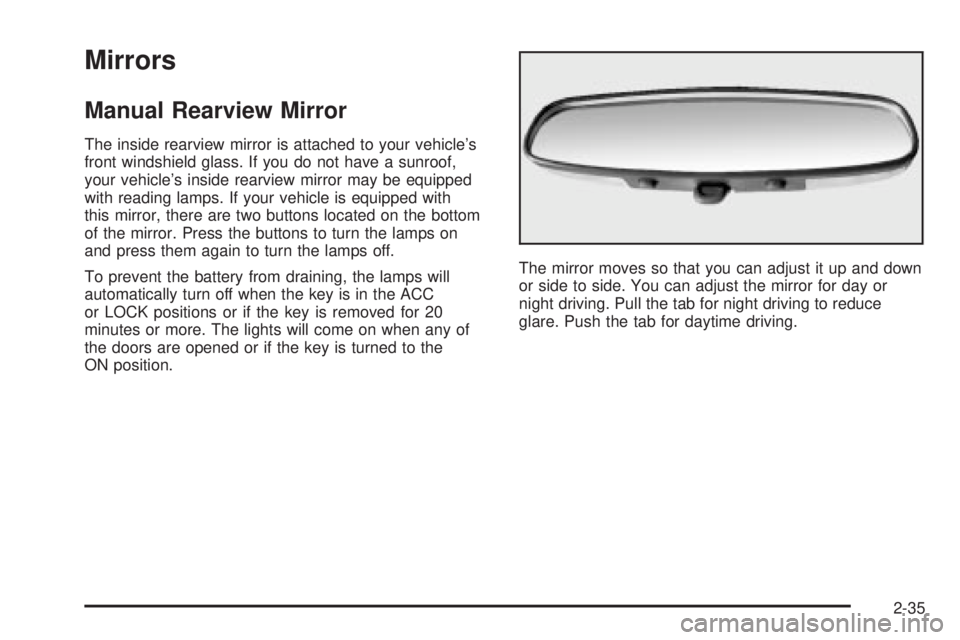
Mirrors
Manual Rearview Mirror
The inside rearview mirror is attached to your vehicle's
front windshield glass. If you do not have a sunroof,
your vehicle's inside rearview mirror may be equipped
with reading lamps. If your vehicle is equipped with
this mirror, there are two buttons located on the bottom
of the mirror. Press the buttons to turn the lamps on
and press them again to turn the lamps off.
To prevent the battery from draining, the lamps will
automatically turn off when the key is in the ACC
or LOCK positions or if the key is removed for 20
minutes or more. The lights will come on when any of
the doors are opened or if the key is turned to the
ON position.The mirror moves so that you can adjust it up and down
or side to side. You can adjust the mirror for day or
night driving. Pull the tab for night driving to reduce
glare. Push the tab for daytime driving.
2-35
Page 100 of 370
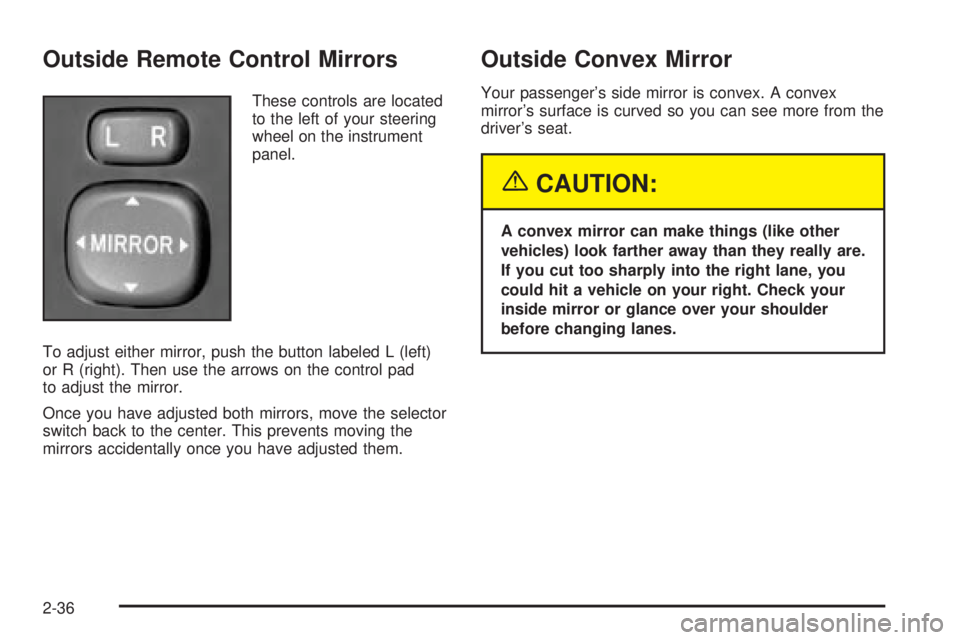
Outside Remote Control Mirrors
These controls are located
to the left of your steering
wheel on the instrument
panel.
To adjust either mirror, push the button labeled L (left)
or R (right). Then use the arrows on the control pad
to adjust the mirror.
Once you have adjusted both mirrors, move the selector
switch back to the center. This prevents moving the
mirrors accidentally once you have adjusted them.
Outside Convex Mirror
Your passenger's side mirror is convex. A convex
mirror's surface is curved so you can see more from the
driver's seat.
{CAUTION:
A convex mirror can make things (like other
vehicles) look farther away than they really are.
If you cut too sharply into the right lane, you
could hit a vehicle on your right. Check your
inside mirror or glance over your shoulder
before changing lanes.
2-36